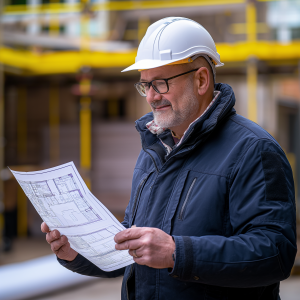Your Blueprint for Success: A Guide to Hiring an Architect in the UK
Initiating a construction project requires meticulous planning, a clear vision, and the right team. An architect plays a crucial role in transforming your visions into functional realities that meet aesthetic desires and comply with local regulations.
This guide aims to navigate you through the process of hiring an architect in the UK, from understanding their essential role and establishing initial project parameters to selecting the right professional and managing the project through to completion. Following this comprehensive approach ensures that your building project is successful, sustainable, and aligned with your long-term objectives.
Understanding the Architect’s Role
The role of an architect is pivotal when starting the journey of constructing or renovating a property. Architects are not merely professionals who create building designs; they are visionaries who transform client aspirations into compliant, functional, and tangible structures. While architects focus significantly on design, their responsibilities extend beyond this to include oversight during construction and ensuring that all designs adhere to local building codes and regulations.
An architect’s influence on a project begins at the very conceptual stage, where they interpret the client’s needs and wishes into an architectural expression that respects budgetary constraints and functional requirements. They navigate the complex landscape of permits and approvals, ensuring that every aspect of the building design meets legal and safety standards. Their expertise not only elevates the aesthetic appeal of a building but also enhances its practicality and sustainability.
Initial Considerations for Your Project
Before hiring an architect, it is crucial to define the scope and goals of your project clearly. Consider what you want to achieve with your build or renovation. Are you looking to create a sustainable home that minimises environmental impact? Or a family residence that can evolve with your changing needs? Setting these objectives upfront will guide your discussions with potential architects and help align your vision with their design philosophy.
Budgeting is another critical consideration. Early on, establish a realistic budget that accounts for all possible expenses. This financial plan should cover construction costs and account for architect fees, which typically range from 10% to 15% of the total construction costs. By understanding these financial aspects early, you can set clear expectations with your architect and avoid future misunderstandings.
How to Find and Choose the Right Architect
Finding the right architect involves a blend of research and personal intuition. Start by identifying licensed professionals with a solid track record and credentials from reputable institutions like the Royal Institute of British Architects (RIBA) or the Architects Registration Board (ARB). These credentials are a testament to their professionalism and adherence to industry standards.
Once you have a shortlist, delve into their portfolios to assess their experience and the diversity of their design work. Each architect has a unique style and approach to problem-solving; look for one whose past projects resonate with your vision and goals. Moreover, the ability to establish a personal connection cannot be overstated. This person will be a close collaborator through what can often be a challenging and lengthy process, so it’s important that you feel comfortable with them.
Evaluating Proposals and Portfolios
When reviewing proposals from architects, scrutinise the scope of work, fees, and the proposed timelines. Clear communication about these aspects can significantly influence the success of your project. Discuss your aspirations, budget, and project scope in detail during initial consultations. This dialogue will help ensure that the architect fully understands and is prepared to meet your requirements.
In examining an architect’s portfolio, look beyond the aesthetics of their previous projects. Consider how effectively they have addressed and resolved issues similar to those you might face, such as site constraints or special zoning laws. This insight can give you confidence in their ability to handle your project’s unique challenges.
Architect Selection Criteria
Selecting an architect should be a meticulous process that considers several key factors. Experience in similar projects to yours can provide reassurance of their capability to manage and execute your project effectively. Communication skills are also crucial; ensure that the architect is someone with whom you can maintain open and regular dialogue. Their ability to convey and interpret ideas will significantly impact the project’s outcome.
Innovative problem-solving skills are another critical criterion. Architecture, especially in challenging builds, often requires creative solutions that balance aesthetic appeal with functionality and compliance with legal standards. Moreover, in today’s world, proficiency with digital tools for remote consultations and project management is increasingly important, making it essential to assess the digital capabilities of your prospective architect.
Setting Budgets and Understanding Fees
Understanding how architects charge for their services will help you budget more effectively. Depending on the project’s complexity and duration, architects may charge a percentage of the overall construction costs, a fixed fee, or hourly rates. Early discussions about fees should include factors affecting costs and payment schedules. This transparency will help prevent disputes and ensure financial dealings do not impact the project’s progress.
The Critical Role of a Contractual Agreement
A detailed contractual agreement is paramount in any architectural project. This contract should comprehensively cover all aspects of each party’s project scope, fees, timelines, and responsibilities. Having a contract in place protects both you and the architect legally and ensures a clear understanding of each party’s expectations and roles. This clarity is crucial for maintaining a positive and productive working relationship throughout the project.
The contract should explicitly outline how changes to the scope or unforeseen circumstances will be handled, including adjustments to fees and timelines. This helps manage expectations and provides a framework for resolving disputes should they arise. It’s advisable to have legal counsel review the contract to ensure it is fair and comprehensive, protecting all involved parties.
Design Collaboration and Effective Project Management
Embarking on a construction or renovation project with an architect is not just about hiring a professional to design a building; it’s about entering into a partnership where both parties contribute to the creative process. Effective collaboration between you and your architect is essential for ensuring that the final design meets your aesthetic and functional requirements and aligns with your personal goals and values.
Regular communication is crucial throughout the design phase. This involves structured meetings and ongoing discussions where ideas can be freely exchanged and iterations refined. You need to stay engaged and provide feedback throughout this process, as it helps the architect understand your preferences and refine their designs accordingly. Moreover, using tools like 3D modelling and virtual reality, architects can provide immersive experiences that better understand the proposed outcomes before any physical work begins.
As the project moves into the construction phase, the architect’s role can shift towards ensuring that the contractors adhere to the design specifications. This project management phase is critical as it involves overseeing the construction to ensure that the work is executed as planned within the stipulated time and budget. The architect acts as your advocate, ensuring the quality of materials and workmanship meets the agreed-upon standards.
Leveraging Technology for Enhanced Planning and Sustainability
Technology plays a pivotal role in today’s architectural practices. Digital tools like Building Information Modeling (BIM) and Virtual Reality (VR) are reshaping how architects plan and execute projects. BIM allows for more accurate building modelling, providing insights into various aspects of the construction process before it even begins. This can lead to more efficient use of resources, reduced waste, and fewer unexpected issues during construction.
Sustainability is another critical consideration in modern architecture. More than ever, we are aware of the environmental impacts of building projects. As such, integrating eco-friendly designs and materials from the outset is not just a preference but a necessity. This involves selecting sustainable materials and incorporating energy-efficient systems, which can significantly reduce the building’s carbon footprint over its lifespan. Architects well-versed in sustainable design can help you make choices that align with environmental stewardship while still achieving aesthetic and functional excellence.
Post-Construction Evaluation and Continuous Improvement
After the construction dust has settled and the last contractor has left the site, the role of your architect may still need to be completed. Post-construction evaluation is critical to ensure the new building looks good and functions as intended. This phase involves the architect and client reviewing the project in detail to identify any aspects needing adjustment or improvement.
One of the key tasks during this evaluation is a thorough walkthrough of the property. Here, you and your architect will assess aspects such as the quality of workmanship, the effectiveness of architectural solutions, and the performance of materials and systems installed. During this walkthrough, it’s essential to address any discrepancies between the original plans and the executed project. This process helps rectify any immediate issues and provides valuable lessons that can be applied to future projects.
Moreover, evaluating the building’s performance over time is crucial. This includes monitoring energy usage, internal environment quality, and structural behaviour under different conditions. Your architect can assist in setting up systems that collect data on these performance metrics. Such ongoing evaluation helps understand how well the building meets energy efficiency and sustainability goals and whether any modifications are necessary to optimise performance.
Conclusive Thoughts
Hiring and collaborating with an architect involves numerous stages, each critical to the project’s success. From the initial planning and design phases through construction and post-construction evaluation, every step requires careful consideration and active participation from both the client and the architect.
Fostering a collaborative relationship based on clear communication and mutual respect can ensure that your architectural project meets and exceeds your expectations while contributing positively to the broader goals of sustainability and innovation in building design.
In conclusion, remember that a successful architectural project is about creating a space that meets current needs and envisioning a future where the structure continues to serve and inspire those who interact with it. Your project can achieve this enduring impact through thoughtful planning, effective collaboration, and a commitment to excellence and sustainability.















